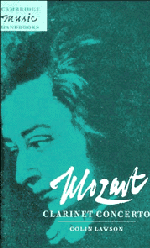Book contents
- Frontmatter
- Contents
- List of illustrations
- Preface
- 1 The eighteenth-century clarinet and its music
- 2 Mozart, Stadler and the clarinet
- 3 The genesis and reception of the Concerto
- 4 Stadler's clarinet and its revival
- 5 Mozart's original text
- 6 Design and structure
- 7 Performance practice
- Appendix 1 A review of the Breitkopf and Härtel edition in the Leipzig Allgemeine Musikalische Zeitung, 4 (March 1802)
- Appendix 2 Surviving instruments
- Appendix 3 A list of works composed by Mozart's clarinettist, Anton Stadler
- Notes
- Select bibliography
- Index
4 - Stadler's clarinet and its revival
Published online by Cambridge University Press: 05 June 2012
- Frontmatter
- Contents
- List of illustrations
- Preface
- 1 The eighteenth-century clarinet and its music
- 2 Mozart, Stadler and the clarinet
- 3 The genesis and reception of the Concerto
- 4 Stadler's clarinet and its revival
- 5 Mozart's original text
- 6 Design and structure
- 7 Performance practice
- Appendix 1 A review of the Breitkopf and Härtel edition in the Leipzig Allgemeine Musikalische Zeitung, 4 (March 1802)
- Appendix 2 Surviving instruments
- Appendix 3 A list of works composed by Mozart's clarinettist, Anton Stadler
- Notes
- Select bibliography
- Index
Summary
Viennese clarinets and basset horns
A variety of evidence testifies to the pre-eminence of Vienna in the development of the classical clarinet. Schubart in 1784–5 singled out the city as an important centre of clarinet manufacture (together with Nuremberg, Munich, Hamburg and Berlin), whilst Backofen c. 1803 stated in his tutor that the finest basset horns were made in Vienna. The homogeneous but distinctive sound-quality of classical Viennese clarinets arises from a number of characteristic and progressive features. In Appendix 2 Nicholas Shackleton discusses and lists various instruments whose design and provenance make them especially relevant to a study of the Mozart Concerto. A recent report on the playing response of the surviving B♭ clarinet by Stadler's collaborator Theodor Lotz (1748–92) confirms its special qualities:
… Playing on this Lotz clarinet, complete in all its components, was certainly a gratifying experience. It probably possessed the largest, ‘thickest’ sound of any eighteenth-century clarinet that I tested, rounded and woody throughout its entire range, in the tradition of the best German players (and instruments!) of today. Particularly impressive were the good intonation between the registers and the evenness of scale in the lower register. Both are significant in light of Mozart's extensive use of this register. The dynamic range and timbral quality of this Lotz clarinet are no doubt related to the very large bore size (between 15.00 and 15.05 mm) found on this instrument, one of the largest I found on any eighteenth-century clarinet and large even by today's standards. […]
- Type
- Chapter
- Information
- Mozart: Clarinet Concerto , pp. 43 - 51Publisher: Cambridge University PressPrint publication year: 1996



